Nandita Vijaykumar
DEQuify your force field: More efficient simulations using deep equilibrium models
Sep 10, 2025Abstract:Machine learning force fields show great promise in enabling more accurate molecular dynamics simulations compared to manually derived ones. Much of the progress in recent years was driven by exploiting prior knowledge about physical systems, in particular symmetries under rotation, translation, and reflections. In this paper, we argue that there is another important piece of prior information that, thus fa,r hasn't been explored: Simulating a molecular system is necessarily continuous, and successive states are therefore extremely similar. Our contribution is to show that we can exploit this information by recasting a state-of-the-art equivariant base model as a deep equilibrium model. This allows us to recycle intermediate neural network features from previous time steps, enabling us to improve both accuracy and speed by $10\%-20\%$ on the MD17, MD22, and OC20 200k datasets, compared to the non-DEQ base model. The training is also much more memory efficient, allowing us to train more expressive models on larger systems.
LuxDiT: Lighting Estimation with Video Diffusion Transformer
Sep 03, 2025Abstract:Estimating scene lighting from a single image or video remains a longstanding challenge in computer vision and graphics. Learning-based approaches are constrained by the scarcity of ground-truth HDR environment maps, which are expensive to capture and limited in diversity. While recent generative models offer strong priors for image synthesis, lighting estimation remains difficult due to its reliance on indirect visual cues, the need to infer global (non-local) context, and the recovery of high-dynamic-range outputs. We propose LuxDiT, a novel data-driven approach that fine-tunes a video diffusion transformer to generate HDR environment maps conditioned on visual input. Trained on a large synthetic dataset with diverse lighting conditions, our model learns to infer illumination from indirect visual cues and generalizes effectively to real-world scenes. To improve semantic alignment between the input and the predicted environment map, we introduce a low-rank adaptation finetuning strategy using a collected dataset of HDR panoramas. Our method produces accurate lighting predictions with realistic angular high-frequency details, outperforming existing state-of-the-art techniques in both quantitative and qualitative evaluations.
DPQuant: Efficient and Differentially-Private Model Training via Dynamic Quantization Scheduling
Sep 03, 2025Abstract:Differentially-Private SGD (DP-SGD) is a powerful technique to protect user privacy when using sensitive data to train neural networks. During training, converting model weights and activations into low-precision formats, i.e., quantization, can drastically reduce training times, energy consumption, and cost, and is thus a widely used technique. In this work, we demonstrate that quantization causes significantly higher accuracy degradation in DP-SGD compared to regular SGD. We observe that this is caused by noise injection in DP-SGD, which amplifies quantization variance, leading to disproportionately large accuracy degradation. To address this challenge, we present QPQuant, a dynamic quantization framework that adaptively selects a changing subset of layers to quantize at each epoch. Our method combines two key ideas that effectively reduce quantization variance: (i) probabilistic sampling of the layers that rotates which layers are quantized every epoch, and (ii) loss-aware layer prioritization, which uses a differentially private loss sensitivity estimator to identify layers that can be quantized with minimal impact on model quality. This estimator consumes a negligible fraction of the overall privacy budget, preserving DP guarantees. Empirical evaluations on ResNet18, ResNet50, and DenseNet121 across a range of datasets demonstrate that DPQuant consistently outperforms static quantization baselines, achieving near Pareto-optimal accuracy-compute trade-offs and up to 2.21x theoretical throughput improvements on low-precision hardware, with less than 2% drop in validation accuracy.
ContraGS: Codebook-Condensed and Trainable Gaussian Splatting for Fast, Memory-Efficient Reconstruction
Sep 03, 2025Abstract:3D Gaussian Splatting (3DGS) is a state-of-art technique to model real-world scenes with high quality and real-time rendering. Typically, a higher quality representation can be achieved by using a large number of 3D Gaussians. However, using large 3D Gaussian counts significantly increases the GPU device memory for storing model parameters. A large model thus requires powerful GPUs with high memory capacities for training and has slower training/rendering latencies due to the inefficiencies of memory access and data movement. In this work, we introduce ContraGS, a method to enable training directly on compressed 3DGS representations without reducing the Gaussian Counts, and thus with a little loss in model quality. ContraGS leverages codebooks to compactly store a set of Gaussian parameter vectors throughout the training process, thereby significantly reducing memory consumption. While codebooks have been demonstrated to be highly effective at compressing fully trained 3DGS models, directly training using codebook representations is an unsolved challenge. ContraGS solves the problem of learning non-differentiable parameters in codebook-compressed representations by posing parameter estimation as a Bayesian inference problem. To this end, ContraGS provides a framework that effectively uses MCMC sampling to sample over a posterior distribution of these compressed representations. With ContraGS, we demonstrate that ContraGS significantly reduces the peak memory during training (on average 3.49X) and accelerated training and rendering (1.36X and 1.88X on average, respectively), while retraining close to state-of-art quality.
UniRelight: Learning Joint Decomposition and Synthesis for Video Relighting
Jun 18, 2025Abstract:We address the challenge of relighting a single image or video, a task that demands precise scene intrinsic understanding and high-quality light transport synthesis. Existing end-to-end relighting models are often limited by the scarcity of paired multi-illumination data, restricting their ability to generalize across diverse scenes. Conversely, two-stage pipelines that combine inverse and forward rendering can mitigate data requirements but are susceptible to error accumulation and often fail to produce realistic outputs under complex lighting conditions or with sophisticated materials. In this work, we introduce a general-purpose approach that jointly estimates albedo and synthesizes relit outputs in a single pass, harnessing the generative capabilities of video diffusion models. This joint formulation enhances implicit scene comprehension and facilitates the creation of realistic lighting effects and intricate material interactions, such as shadows, reflections, and transparency. Trained on synthetic multi-illumination data and extensive automatically labeled real-world videos, our model demonstrates strong generalization across diverse domains and surpasses previous methods in both visual fidelity and temporal consistency.
Squeeze3D: Your 3D Generation Model is Secretly an Extreme Neural Compressor
Jun 09, 2025Abstract:We propose Squeeze3D, a novel framework that leverages implicit prior knowledge learnt by existing pre-trained 3D generative models to compress 3D data at extremely high compression ratios. Our approach bridges the latent spaces between a pre-trained encoder and a pre-trained generation model through trainable mapping networks. Any 3D model represented as a mesh, point cloud, or a radiance field is first encoded by the pre-trained encoder and then transformed (i.e. compressed) into a highly compact latent code. This latent code can effectively be used as an extremely compressed representation of the mesh or point cloud. A mapping network transforms the compressed latent code into the latent space of a powerful generative model, which is then conditioned to recreate the original 3D model (i.e. decompression). Squeeze3D is trained entirely on generated synthetic data and does not require any 3D datasets. The Squeeze3D architecture can be flexibly used with existing pre-trained 3D encoders and existing generative models. It can flexibly support different formats, including meshes, point clouds, and radiance fields. Our experiments demonstrate that Squeeze3D achieves compression ratios of up to 2187x for textured meshes, 55x for point clouds, and 619x for radiance fields while maintaining visual quality comparable to many existing methods. Squeeze3D only incurs a small compression and decompression latency since it does not involve training object-specific networks to compress an object.
DiffusionRenderer: Neural Inverse and Forward Rendering with Video Diffusion Models
Jan 30, 2025



Abstract:Understanding and modeling lighting effects are fundamental tasks in computer vision and graphics. Classic physically-based rendering (PBR) accurately simulates the light transport, but relies on precise scene representations--explicit 3D geometry, high-quality material properties, and lighting conditions--that are often impractical to obtain in real-world scenarios. Therefore, we introduce DiffusionRenderer, a neural approach that addresses the dual problem of inverse and forward rendering within a holistic framework. Leveraging powerful video diffusion model priors, the inverse rendering model accurately estimates G-buffers from real-world videos, providing an interface for image editing tasks, and training data for the rendering model. Conversely, our rendering model generates photorealistic images from G-buffers without explicit light transport simulation. Experiments demonstrate that DiffusionRenderer effectively approximates inverse and forwards rendering, consistently outperforming the state-of-the-art. Our model enables practical applications from a single video input--including relighting, material editing, and realistic object insertion.
INRet: A General Framework for Accurate Retrieval of INRs for Shapes
Jan 27, 2025



Abstract:Implicit neural representations (INRs) have become an important method for encoding various data types, such as 3D objects or scenes, images, and videos. They have proven to be particularly effective at representing 3D content, e.g., 3D scene reconstruction from 2D images, novel 3D content creation, as well as the representation, interpolation, and completion of 3D shapes. With the widespread generation of 3D data in an INR format, there is a need to support effective organization and retrieval of INRs saved in a data store. A key aspect of retrieval and clustering of INRs in a data store is the formulation of similarity between INRs that would, for example, enable retrieval of similar INRs using a query INR. In this work, we propose INRet, a method for determining similarity between INRs that represent shapes, thus enabling accurate retrieval of similar shape INRs from an INR data store. INRet flexibly supports different INR architectures such as INRs with octree grids, triplanes, and hash grids, as well as different implicit functions including signed/unsigned distance function and occupancy field. We demonstrate that our method is more general and accurate than the existing INR retrieval method, which only supports simple MLP INRs and requires the same architecture between the query and stored INRs. Furthermore, compared to converting INRs to other representations (e.g., point clouds or multi-view images) for 3D shape retrieval, INRet achieves higher accuracy while avoiding the conversion overhead.
Photorealistic Object Insertion with Diffusion-Guided Inverse Rendering
Aug 19, 2024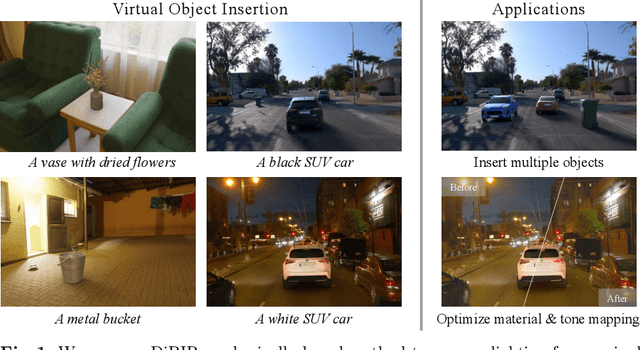

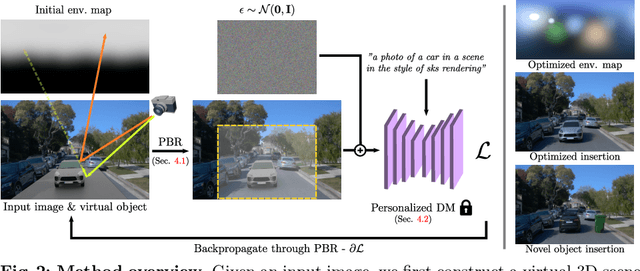

Abstract:The correct insertion of virtual objects in images of real-world scenes requires a deep understanding of the scene's lighting, geometry and materials, as well as the image formation process. While recent large-scale diffusion models have shown strong generative and inpainting capabilities, we find that current models do not sufficiently "understand" the scene shown in a single picture to generate consistent lighting effects (shadows, bright reflections, etc.) while preserving the identity and details of the composited object. We propose using a personalized large diffusion model as guidance to a physically based inverse rendering process. Our method recovers scene lighting and tone-mapping parameters, allowing the photorealistic composition of arbitrary virtual objects in single frames or videos of indoor or outdoor scenes. Our physically based pipeline further enables automatic materials and tone-mapping refinement.
Proteus: Preserving Model Confidentiality during Graph Optimizations
Apr 18, 2024
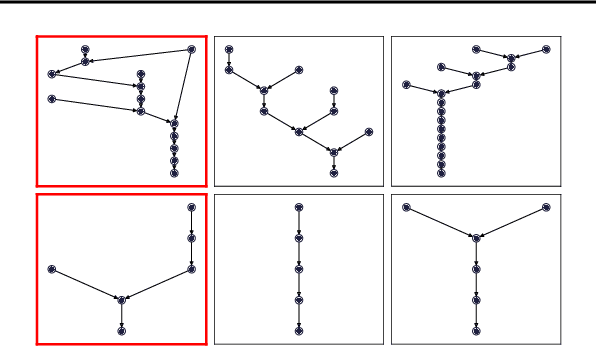
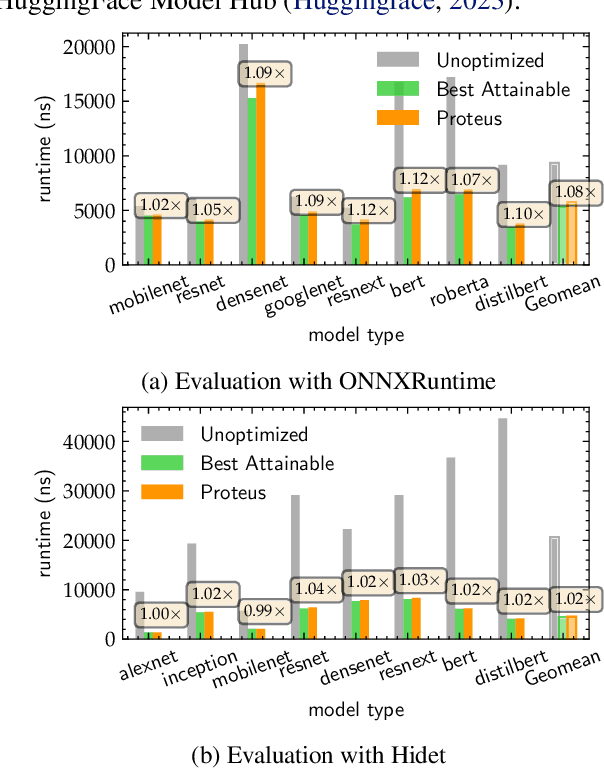
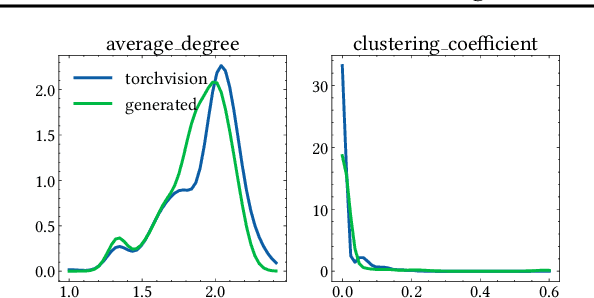
Abstract:Deep learning (DL) models have revolutionized numerous domains, yet optimizing them for computational efficiency remains a challenging endeavor. Development of new DL models typically involves two parties: the model developers and performance optimizers. The collaboration between the parties often necessitates the model developers exposing the model architecture and computational graph to the optimizers. However, this exposure is undesirable since the model architecture is an important intellectual property, and its innovations require significant investments and expertise. During the exchange, the model is also vulnerable to adversarial attacks via model stealing. This paper presents Proteus, a novel mechanism that enables model optimization by an independent party while preserving the confidentiality of the model architecture. Proteus obfuscates the protected model by partitioning its computational graph into subgraphs and concealing each subgraph within a large pool of generated realistic subgraphs that cannot be easily distinguished from the original. We evaluate Proteus on a range of DNNs, demonstrating its efficacy in preserving confidentiality without compromising performance optimization opportunities. Proteus effectively hides the model as one alternative among up to $10^{32}$ possible model architectures, and is resilient against attacks with a learning-based adversary. We also demonstrate that heuristic based and manual approaches are ineffective in identifying the protected model. To our knowledge, Proteus is the first work that tackles the challenge of model confidentiality during performance optimization. Proteus will be open-sourced for direct use and experimentation, with easy integration with compilers such as ONNXRuntime.
 Add to Chrome
Add to Chrome Add to Firefox
Add to Firefox Add to Edge
Add to Edge